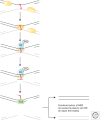Diseases associated with defective responses to DNA damage
- PMID: 23209155
- PMCID: PMC3504433
- DOI: 10.1101/cshperspect.a012773
Diseases associated with defective responses to DNA damage
Abstract
Within the last decade, multiple novel congenital human disorders have been described with genetic defects in known and/or novel components of several well-known DNA repair and damage response pathways. Examples include disorders of impaired nucleotide excision repair, DNA double-strand and single-strand break repair, as well as compromised DNA damage-induced signal transduction including phosphorylation and ubiquitination. These conditions further reinforce the importance of multiple genome stability pathways for health and development in humans. Furthermore, these conditions inform our knowledge of the biology of the mechanics of genome stability and in some cases provide potential routes to help exploit these pathways therapeutically. Here, I will review a selection of these exciting findings from the perspective of the disorders themselves, describing how they were identified, how genotype informs phenotype, and how these defects contribute to our growing understanding of genome stability pathways.
Figures





References
-
- Ahel I, Rass U, El-Khamisy SF, Katyal S, Clements PM, McKinnon PJ, Caldecott KW, West SC 2006. The neurodegenerative disease protein aprataxin resolves abortive DNA ligation intermediates. Nature 443: 713–716 - PubMed
-
- Ahmad S, Teebi RJG 1997. Not a new Seckel-like syndrome but ear-patella-short stature syndrome. Am J Med Genet 70: 454. - PubMed
-
- Ahnesorg P, Smith P, Jackson SP 2006. XLF interacts with the XRCC4-DNA ligase IV complex to promote DNA nonhomologous end-joining. Cell 124: 301–313 - PubMed
-
- Aicardi J, Goutieres F 1984. A progressive familial encephalopathy in infancy with calcifications of the basal ganglia and chronic cerebrospinal fluid lymphocytosis. Ann Neurol 15: 49–54 - PubMed
-
- Alderton GK, Joenje H, Varon R, Borglum AD, Jeggo PA, O’Driscoll M 2004. Seckel syndrome exhibits cellular features demonstrating defects in the ATR signalling pathway. Hum Mol Genet 13: 3127–3138 - PubMed
Publication types
MeSH terms
Substances
LinkOut - more resources
Full Text Sources
Other Literature Sources
Medical
